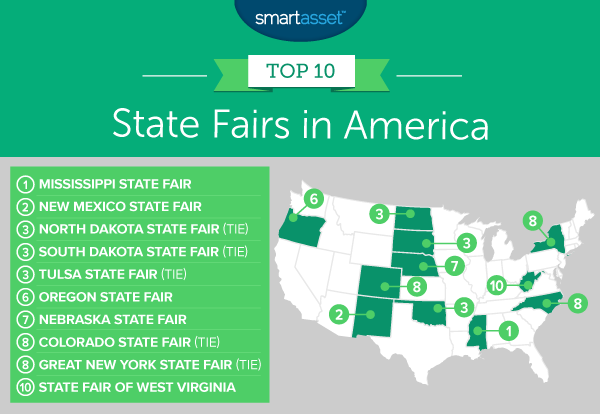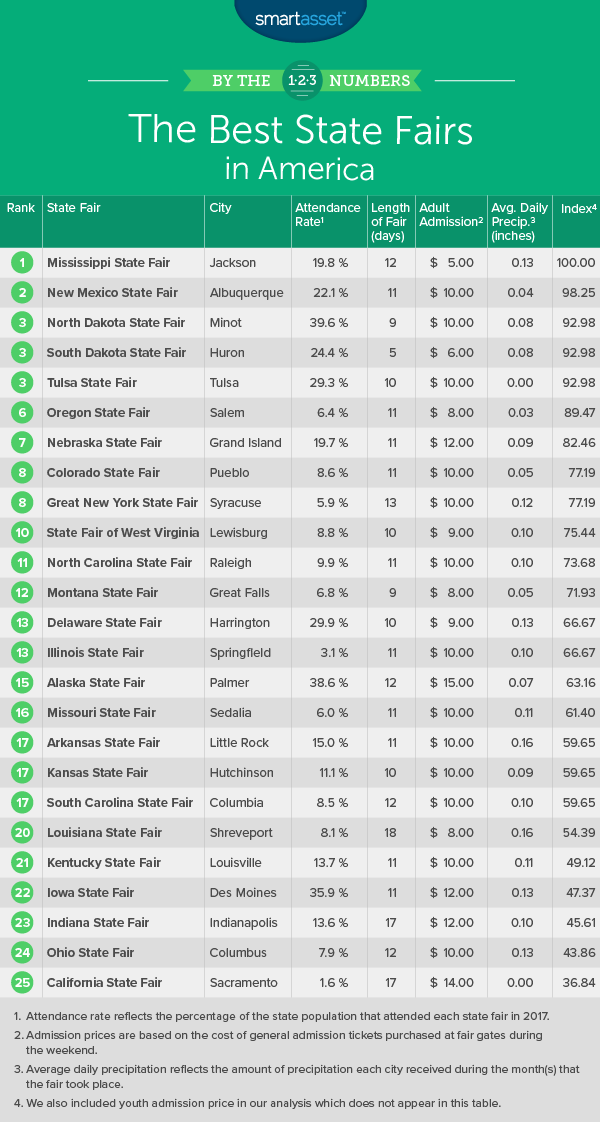Millions of Americans attend state fairs across the country every year. From rides and concerts to games and fried food, there’s something for everyone at a state fair. And with rising costs of living, state fairs are one of the few entertainment options which the majority of Americans can afford without breaking into their savings accounts. However state fairs vary widely by location. Some state fairs last for weeks and are attended by large chunks of the state’s population. Others are only a few days and go by almost unnoticed by the state’s residents.
In order to rank America’s best state fairs, we analyzed data across five factors. We looked at the length of the fairs, attendance rates, cost of general admission for adults and children and weather. Check out our data and methodology section below, to see where we got our data and how we put it together.
Key Findings
- Consistency – Many of last year’s top 10 state fairs took home ribbons in this year’s edition. The top three fairs – the Mississippi State Fair, the New Mexico State Fair and the North Dakota State Fair – all kept their top 10 spots.
- Weather is a big deal – If you love attending your state’s fair you will know how important weather is. For example in Oregon, record-hot temperatures melted fairgoers’ enthusiasm, while in Mississippi, rain put a damper on attendance. Fluctuations in weather can have a big impact on attendance.

This is SmartAsset’s third annual study on the best state fairs in America. Read last year’s study here.
1. Mississippi State Fair
Once again, the Mississippi State Fair tops the list as the best state fair in America. This fair is in town for 12 days, making it one of the longest state fairs in our study. Another reason it ranks so highly is because it is an affordable event for the whole family. Admission for adults and children is only $5.
Thanks to rain on the first weekend of the fair in 2017, attendance was down from the record-setting year of 2016. But overall the equivalent of 20% of the state attended the 2017 Mississippi State Fair. For that metric, it ranks ninth.
2. New Mexico State Fair
The New Mexico State Fair hung on to second place for the second straight year. Over 462,000 people attended the New Mexico State Fair in 2017, a slight decrease from 2016. According to officials, the reason for the decline was a mix of bad weather and construction along Central Avenue for the Albuquerque Rapid Transit Project.
Despite the slight decrease in attendance, the equivalent of 22% of New Mexicans still attended the state fair, a top 10 mark. Adult admissions to this fair are also fairly affordable at only $10 per adult. The New Mexico State Fair’s best score came in chance of precipitation. This area usually gets less than 0.1 inches of rain per day during the month that the fair is held, the third-lowest score in our study.
3. (tie) North Dakota State Fair
If we were scoring only by attendance, North Dakota would have an argument for the top spot. Attendance at the 2017 North Dakota State Fair fell just short of 300,000, a 2% increase from the year before. While that number may not blow you away, it’s the equivalent of two out of every five North Dakotans attending the state fair. In that metric, the state ranks first.
This state fair also ranks in the top 10 for youth admission price, adult admission price and average inches of precipitation. The only downside to the North Dakota State Fair is the length. At only nine days, it is the second-shortest state fair in our top 10.
3. (tie) South Dakota State Fair
South Dakota is tied with its neighbor to the north for third. Like the North Dakota State Fair, the South Dakota State Fair is relatively short but still well-attended.
The main reason South Dakota ranks so well is because of its affordability. Adults attending this state fair will pay $6 and children only cost $4. That means a full day of family fun, including watching cheese sculpting and arm-wrestling competitions, for two adults and two children costs only $20.
3. (tie) Tulsa State Fair
Last year, we were missing data for the Tulsa State Fair so it was not part of this study. This year, it tied with the North Dakota and South Dakota State Fairs for third. Overall around 1.15 million people attended the Tulsa State Fair, which is almost 30% of the state’s population. As a bonus: it almost never rains in Tulsa in September or October.
If you are thinking about attending this year, Disney on Ice will be at the Tulsa State Fair, although you will have to pay extra for tickets. Other fun events include the livestock show and the Oklahoma State Picking and Fiddling Championships.
6. Oregon State Fair
The Oregon State Fair fell from fourth place last year to sixth place this year. One reason for the decline in our rankings is the decline in attendance. Thanks to unfriendly fair weather, officials estimate attendance fell by around 10% between 2016 and 2017. On seven of the 11 days of the fair, temperatures topped 90 degrees.
Still, the Oregon State Fair is an affordable place to spend a day or a weekend. Combined, one adult and one youth ticket would cost only $14. In both of those metrics, Oregon ranks in the top 15.
7. Nebraska State Fair
In 2017, the Nebraska State Fair saw 379,108 fairgoers. That was about 10,000 people shy of the all-time attendance record set in 1997. The 379,108 fairgoers are equal to about 20% of the state’s population.
Adult admission to this state fair is on the high side at $12. However families with younger children will be able to keep their checking accounts in tact, thanks to the affordable youth admission price. A youth ticket to the Nebraska State Fair costs only $3.
8. (tie) Colorado State Fair
The Colorado State Fair is tied for eighth, an improvement on last year’s ninth-place finish. The main reason for the climb is an increase in attendance. From 2016 to 2017, attendance at the Colorado State Fair increased by 13,600, or roughly 3%. That means the number of fairgoers were equivalent to 9% of the state’s population. Another metric in Colorado’s favor is the weather. Pueblo, Colorado – where the state fair is held – is pretty dry in August and September.
If you are looking to attend the Colorado State Fair on a budget, there are plenty of free attractions. Last year’s free attractions included a petting zoo, a Sea Lion Splash Show and Antique Tractors, among other things.
8. (tie) Great New York State Fair
Over 1.16 million people attended the 2017 version of the Great New York State Fair. That makes it one of the best-attended state fairs in the country. However New York is a highly populated state, so 1.16 million attendees is only equivalent to 6% of the state’s population.
This fair provides great value. It runs for 13 days, the fifth-longest in the study, and children get in for free. In terms of length and cost, you will struggle to find a better state fair.
10. State Fair of West Virginia
Rounding out the list of the best state fairs is the State Fair of West Virginia. This state fair runs for 10 days and is held in Lewisburg. This fair scored high marks for affordability. Adult tickets cost only $9 and children can enter for free.
With all the money saved on admission, you can probably afford to splurge a little on things to do at the fair. Maybe attend a concert or get an extra fried dough or two.

Data and Methodology
In order to find the best state fairs, we looked at data for 32 state fairs. That was all the state fairs in the country for which we had full data sets. Specifically, we compared them across the following five metrics:
- State fair length. This is the number of days the state fair is held. Data comes from state fair websites.
- State fair attendance rate. This is the number of people who attended each state fair divided by the state’s population. Data comes from state fair websites and other research.
- Adult admission price. This is the cost of admission for an adult. Data comes from state fair websites.
- Youth admission price. This is the cost of admission for a child. In general this data reflects the cost of admission for a child between the ages of 6 and 12, but it varies by state. Data comes from state fair websites.
- Average daily precipitation data. Data comes from the National Oceanic and Atmospheric Administration (NOAA). We used NOAA’s monthly normals data, which takes 30 years of weather data into account. We specifically considered the average precipitation that fell during the months that the state fair is held.
First, we ranked each fair in each metric. Then we found each fair’s average ranking, giving equal weight to all metrics. Using this average ranking, we created our final index. The state fair with the best average ranking received a score of 100. The state with the worst average ranking received a 0.
Tips for Stretching Your Savings
- Find the right savings account – There are savings accounts with interest rates above 1.5%. Ally, Synchrony and Marcus by Goldman Sachs are three banks which offer savings accounts with interest rates above 1.5%. The national average interest rate is only 0.09% so by choosing one of these banks, you are increasing your returns by 15 times.
- Talk to an expert – A financial advisor can help you with all your major financial decisions, including when and how to invest. If you are not sure where to find a financial advisor, try SmartAsset’s financial advisor matching tool. It will match you with up to three local financial advisors who fit your specific needs.
Questions about our study? Contact us at press@smartasset.com.
Photo credit: ©iStock.com/wundervisuals
